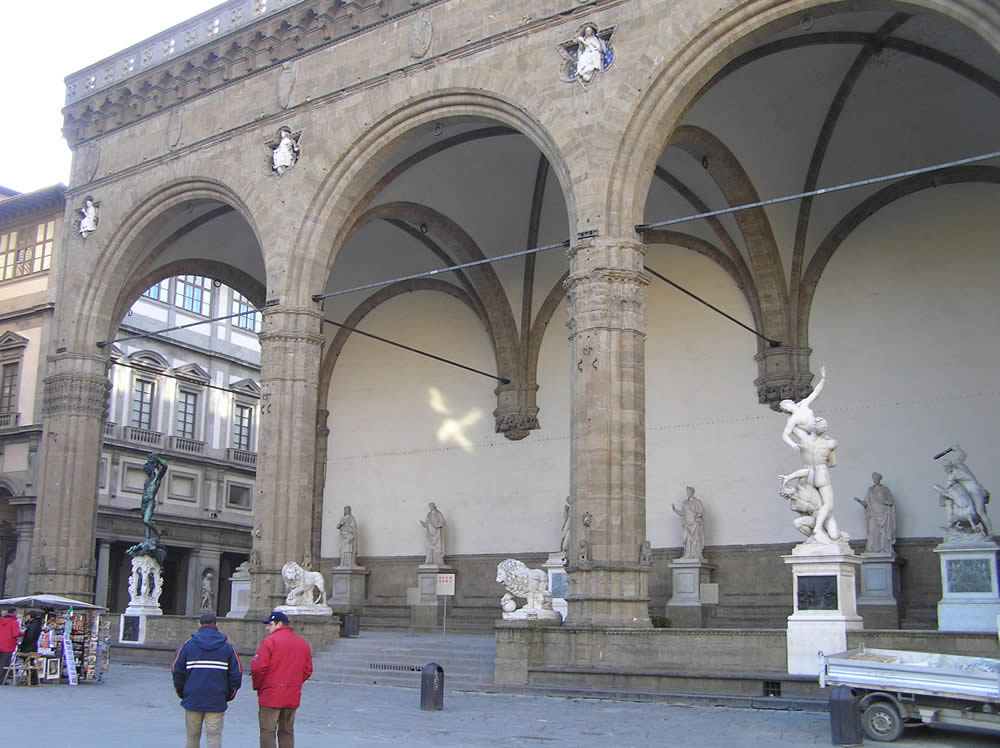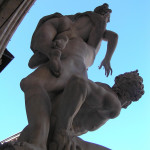Questo articolo è disponibile anche in:
![]() Français
Français ![]() Deutsch
Deutsch ![]() Español
Español ![]() Italiano
Italiano
The Loggia della Signoria, also called Loggia dei Lanzi because of the guard of German mercenaries (lansquenets) who stood here in the sixteenth century, was built in the fourteenth century thanks to the work of Simone di Francesco Talenti, Lorenzo di Filippo and Benci di Cione.
This structure was originally used to host indoor public popular assemblies and official ceremonies of the Florentine Republic in the presence of the people, such as those of settlement of the lordships. The Loggia overlooks Piazza della Signoria right in front of the main entrance of Palazzo Vecchio.
AN OPEN SKY MUSEUM IN THE CENTER OF FLORENCE
The four panels date back to the fourteenth century with allegorical figures of the theological and cardinal Virtues (1383-1386) executed on a design by Agnolo Gaddi and placed in correspondence with the columns of the arches. Starting from the sixteenth century, at the behest of the Medici, the Loggia was destined to house some sculptural masterpieces, becoming one of the first exhibition spaces in the world.
In the sixteenth century the Loggia was used by the Grand Dukes for the festival of Homages of the cities subject to Florence and housed the statues of Giuditta and Holofernes (1455-1460) by Donatello (now in Palazzo Vecchio), by Perseo (1545-1554) by Benvenuto Cellini, of the Rape of the Sabines (1581-1583) by Giambologna. In 1583, at the end of the Uffizi palace, Bernardo Buontalenti created on the top of the loggia, a roof garden for the use of the Grand Dukes, a terrace, now part of the bar of the Uffizi museum.
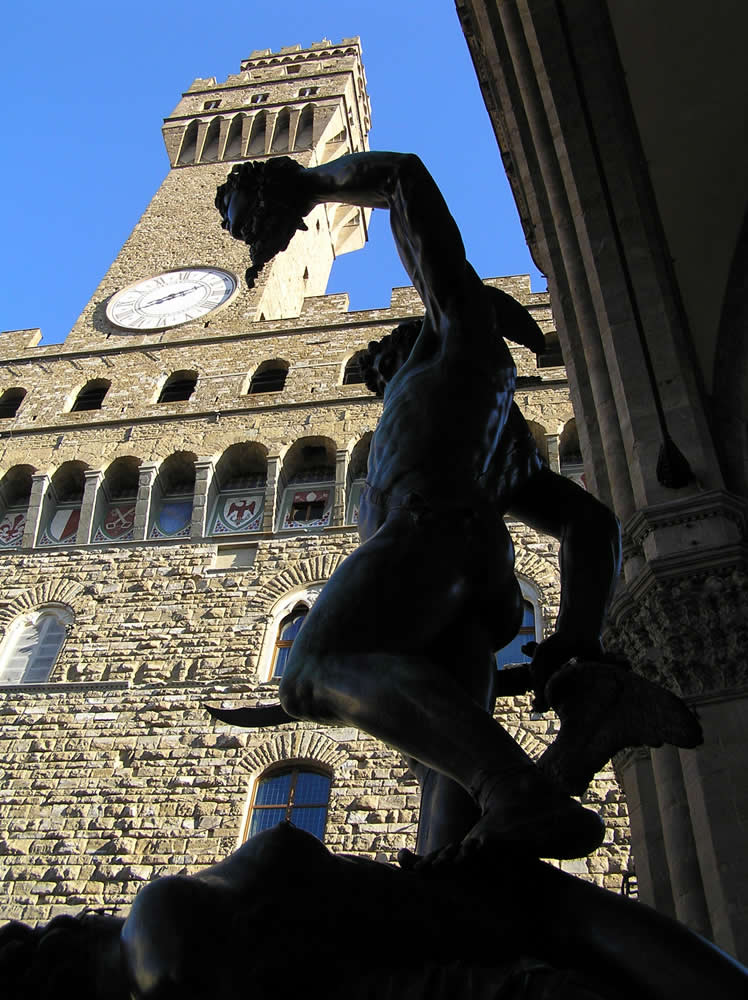
At the end of the 18th century, the Lorraine family also transferred the statues of two Lions (one Roman fragment, the other sculpted (by Flamino Vacca) at the time on a Roman capital) from Villa Medici in Rome, as well as six Roman statues of matrons. In 1841 the Centaur of Giambologna and the ancient group of Menelaus and Patroclus were placed in the center of the Loggia Ercole. Finally in 1866 the Ratto di Polissena by Pio Fedi was added.
THE WORKS EXHIBITED IN THE LOGGIA DELLA SIGNORIA OR LOGGIA DEI LANZI
Today the Loggia della Signoria keeps invaluable sculpture masterpiece, all original, and enjoyed freely day and night. It is effectively a marvellous open-air sculpture gallery of antique and Renaissance art. The following are the sculptures in the Loggia:
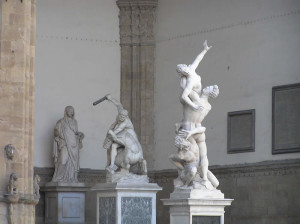
LION (1594-1598)
Marble work by Flaminio Vacca (Rome 1538- Rome 1605). Coming from Villa Medici in Rome, it reached Florence in 1787, in 1789 it was placed under the Loggia.
PERSEUS (1545-1554)
Bronze work by Benvenuto Cellini (Florence 1500-Florence 1571). The statue is under the Loggia since 1554. The original of the base is at the Museo Nazionale del Bargello.
PIRRO RAPES POLYXENA (1860-1865)
Marble work by Pio Fedi (Viterbo 1816-Florence 1892). The statue is under the Loggia since 1865.
ROMAN LADY called SABINE
Marble work of trajan-hadrian age (beginning of 2th century after Christ). Coming from Villa Medici in Rome, it reached Florence in 1787, in 1789 it was placed under the Loggia.
ROMAN LADY called SABINE
Marble work of trajan-hadrian age (beginning of 2th century after Christ). Coming from Villa Medici in Rome, it reached Florence in 1787, in 1789 it was placed under the Loggia.
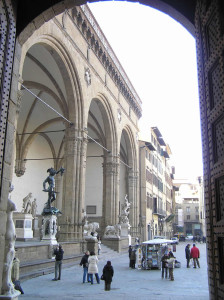
BARBARIAN PRISONIER called THUSNELDA
Marble work of trajian-hadrian age (beginning of 2th century after Christ). Coming from Villa Medici in Rome, it reached Florence in 1787, in 1789 it was placed under the Loggia.
MENELAUS SUPPORTING THE BODY OF PATROCLUS
Copy of flavian age of a Greek original of 240-230 bC. In 1570 it was placed near Ponte Vecchio, in 1741 it was placed under the Loggia.
ROMAN LADY called SABINE with marble portrait of Matilda
Marble work of trajan-hadrian age (beginning of 2th century after Christ). Coming from Villa Medici in Rome, it reached Florence in 1787, in 1789 it was placed under the Loggia.
ROMAN LADY called SABINE
Marble work of trajan-hadrian age (beginning of 2th century after Christ). Coming from Villa Medici in Rome, it reached Florence in 1787, in 1789 it was placed under the Loggia.
ROMAN LADY called SABINE
Marble work of trajan-hadrian age (beginning of 2th century after Christ). Coming from Villa Medici in Rome, it reached Florence in 1787, in 1789 it was placed under the Loggia.
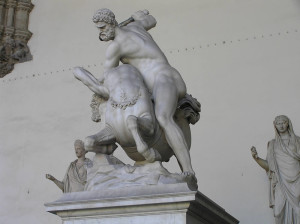
HERCULES FIGHTING THE CENTAUR NESSUS (1594-1599)
Marble work by Giambologna (Jean de Boulogne) (Douai, France 1524-Florence 1608) with the help of Pietro Francavilla (Cambrai 1546 ?-Paris 1615). In origin in the Canto dei Carnesecchi, in 1841 was placed under the Loggia.
LATIN INSCRIPTION (1750)
Inscription in marble commemorating the change of the Florentine calendar in 1749 to bring it into line with the Roman calendar. The Florentine calendar began on 25 March instead of 1 January.
INSCRIPTION (1893)
Inscription in marble records the Florentines who distinguished themselves during the independence wars (1848-1870).
RAPE OF THE SABINE WOMEN (1581-1583)
Marble and bronze work by Giambologna (Jean de Boulogne) (Douai, France 1524-Florence 1608). The statue is under the Loggia since 1583.
LION
Marble work (2th century after Christ). Coming from Villa Medici in Rome, it reached Florence in 1787, in 1789 it was placed under the Loggia.
Questo articolo è disponibile anche in:
![]() Français
Français ![]() Deutsch
Deutsch ![]() Español
Español ![]() Italiano
Italiano

